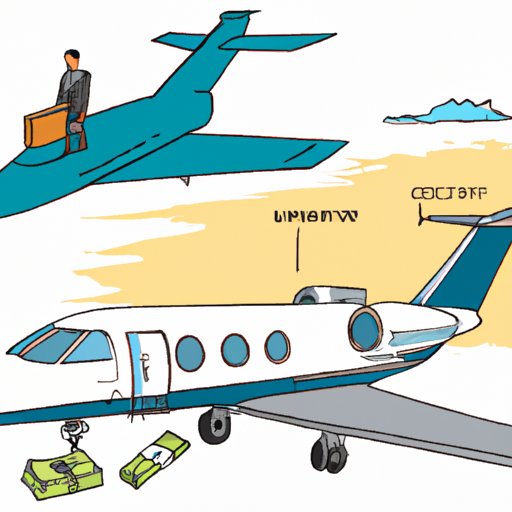Introduction
For those who want to travel in style and luxury, private jet ownership is an attractive option. Private jets provide travelers with the opportunity to get to their destination quickly and conveniently, avoiding the hassles and delays that come with commercial air travel. But how much does a private jet really cost? In this article, we’ll explore the various costs associated with purchasing and maintaining your own private jet, as well as alternative options for getting around without having to buy a plane.
Breaking Down the Cost of Private Jet Ownership
The cost of purchasing a private jet will depend on the type and size of the aircraft, as well as its age and condition. A brand new light jet may cost anywhere from $2 million to more than $10 million, while a used light jet can be purchased for around $1 million. Mid-size jets typically range in price from $4 million to $20 million, while heavy jets can cost anywhere from $15 million to more than $50 million. Ultra-long range jets are the most expensive, with prices ranging from $30 million to over $100 million.
In addition to the initial purchase price, there are also recurring costs associated with owning a private jet. These include fuel expenses, hangar fees, insurance, pilot salaries, and aircraft upgrades. Fuel expenses can vary greatly depending on the type of aircraft, with light jets typically using less fuel than mid-size or heavy jets. Hangar fees can range from a few hundred dollars per month for a small hangar to several thousand dollars per month for a large hangar. Insurance and pilot salaries will also need to be taken into account when budgeting for a private jet.
Comparing Prices of Different Types of Private Jets
Light jets are the least expensive type of aircraft, making them a popular choice for those looking to purchase their first private jet. These aircraft typically seat up to eight passengers and have a range of up to 1,500 miles. Some popular models include the Cessna Citation Mustang and the Embraer Phenom 100.
Mid-size jets are the next step up in terms of size and cost. These planes seat up to twelve passengers and have a range of up to 3,000 miles. Popular models include the Hawker 800XP and the Gulfstream G280.
Heavy jets are the largest and most expensive type of aircraft. They typically seat up to sixteen passengers and have a range of up to 6,000 miles. Popular models include the Gulfstream G450 and the Bombardier Global Express.
Ultra-long range jets are the most expensive type of aircraft. They typically seat up to eighteen passengers and have a range of up to 8,000 miles. Popular models include the Gulfstream G650ER and the Airbus ACJ320neo.

The Pros and Cons of Purchasing a Private Jet
Owning a private jet comes with both benefits and drawbacks. On the plus side, private jets provide travelers with increased flexibility and convenience, allowing them to avoid long security lines and crowded airports. They also offer greater privacy and comfort, allowing travelers to relax in a more luxurious environment. Additionally, many private jets are equipped with amenities such as Wi-Fi and entertainment systems.
On the downside, owning a private jet is a significant financial commitment. Not only do you have to pay the initial purchase price, but you also have to factor in recurring expenses such as fuel, hangar fees, and insurance. Additionally, private jets require regular maintenance and upgrades, which can add to the overall cost of ownership.

Exploring Alternatives to Buying a Private Jet
Purchasing a private jet isn’t the only option for those looking to travel in style and luxury. Another popular option is charter services, which allow travelers to rent a private jet for a one-time flight. This is a great option for those who don’t fly often or don’t want to commit to the cost of owning a private jet. Additionally, there are fractional ownership programs available, which allow individuals to purchase a share of a private jet and use it for a set number of hours each year.

Analyzing the Cost of Operating and Maintaining a Private Jet
In addition to the initial purchase price, there are several other costs associated with operating and maintaining a private jet. Fuel expenses can vary greatly depending on the type of aircraft and length of the flight. Hangar fees can range from a few hundred dollars per month for a small hangar to several thousand dollars per month for a large hangar. Insurance premiums can also be quite costly, depending on the type of coverage and the value of the aircraft.
Pilots also need to be taken into account when budgeting for a private jet. Professional pilots typically charge between $200 and $400 per hour, depending on their experience and qualifications. Finally, aircraft upgrades such as new engines or avionics can cost tens of thousands of dollars.
Conclusion
The cost of purchasing and maintaining a private jet can be considerable, but for those who value the convenience, luxury, and privacy that private jet ownership provides, it can be well worth the expense. Before making the decision to purchase a private jet, it’s important to consider all of the associated costs and weigh them against the benefits. Alternatives such as charter services and fractional ownership programs can also be explored, as they can provide a more affordable way to experience the benefits of private jet travel.
(Note: Is this article not meeting your expectations? Do you have knowledge or insights to share? Unlock new opportunities and expand your reach by joining our authors team. Click Registration to join us and share your expertise with our readers.)
